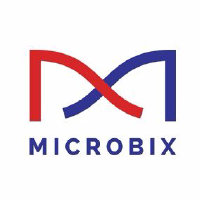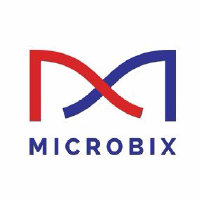
Microbix Biosystems Inc
TSX:MBX


| US |

|
Johnson & Johnson
NYSE:JNJ
|
Pharmaceuticals
|
| US |

|
Berkshire Hathaway Inc
NYSE:BRK.A
|
Financial Services
|
| US |

|
Bank of America Corp
NYSE:BAC
|
Banking
|
| US |

|
Mastercard Inc
NYSE:MA
|
Technology
|
| US |

|
UnitedHealth Group Inc
NYSE:UNH
|
Health Care
|
| US |

|
Exxon Mobil Corp
NYSE:XOM
|
Energy
|
| US |

|
Pfizer Inc
NYSE:PFE
|
Pharmaceuticals
|
| US |

|
Palantir Technologies Inc
NYSE:PLTR
|
Technology
|
| US |

|
Nike Inc
NYSE:NKE
|
Textiles, Apparel & Luxury Goods
|
| US |

|
Visa Inc
NYSE:V
|
Technology
|
| CN |

|
Alibaba Group Holding Ltd
NYSE:BABA
|
Retail
|
| US |

|
JPMorgan Chase & Co
NYSE:JPM
|
Banking
|
| US |

|
Coca-Cola Co
NYSE:KO
|
Beverages
|
| US |

|
Walmart Inc
NYSE:WMT
|
Retail
|
| US |

|
Verizon Communications Inc
NYSE:VZ
|
Telecommunication
|
| US |

|
Chevron Corp
NYSE:CVX
|
Energy
|
Utilize notes to systematically review your investment decisions. By reflecting on past outcomes, you can discern effective strategies and identify those that underperformed. This continuous feedback loop enables you to adapt and refine your approach, optimizing for future success.
Each note serves as a learning point, offering insights into your decision-making processes. Over time, you'll accumulate a personalized database of knowledge, enhancing your ability to make informed decisions quickly and effectively.
With a comprehensive record of your investment history at your fingertips, you can compare current opportunities against past experiences. This not only bolsters your confidence but also ensures that each decision is grounded in a well-documented rationale.
Do you really want to delete this note?
This action cannot be undone.

| 52 Week Range |
0.21
0.55
|
| Price Target |
|
We'll email you a reminder when the closing price reaches CAD.
Choose the stock you wish to monitor with a price alert.

|
Johnson & Johnson
NYSE:JNJ
|
US |

|
Berkshire Hathaway Inc
NYSE:BRK.A
|
US |

|
Bank of America Corp
NYSE:BAC
|
US |

|
Mastercard Inc
NYSE:MA
|
US |

|
UnitedHealth Group Inc
NYSE:UNH
|
US |

|
Exxon Mobil Corp
NYSE:XOM
|
US |

|
Pfizer Inc
NYSE:PFE
|
US |

|
Palantir Technologies Inc
NYSE:PLTR
|
US |

|
Nike Inc
NYSE:NKE
|
US |

|
Visa Inc
NYSE:V
|
US |

|
Alibaba Group Holding Ltd
NYSE:BABA
|
CN |

|
JPMorgan Chase & Co
NYSE:JPM
|
US |

|
Coca-Cola Co
NYSE:KO
|
US |

|
Walmart Inc
NYSE:WMT
|
US |

|
Verizon Communications Inc
NYSE:VZ
|
US |

|
Chevron Corp
NYSE:CVX
|
US |
This alert will be permanently deleted.
Microbix Biosystems Inc
Microbix Biosystems, Inc. engages in developing and commercializing proprietary biological and technology solutions for human health and wellbeing. The company is headquartered in Mississauga, Ontario. The firm manufactures a range of biological materials for the diagnostics industry, notably antigens (Antigen business) used in immunoassays and its quality assessment and proficiency testing controls (QAPs business). The firm operates in two segments: the development, manufacturing, and sales of antigens as materials for the medical diagnostic industry or as quality assessment products (as finished products) and viral transport medium (VTM) and the development and commercialization of products or technologies such as Kinlytic and . The Kinlyti urokinase, which is a biologic thrombolytic drug used to treat blood clots. The firm's catalogue of catalogue covers a range of pathogens that are implicated in maternal, pediatric, childhood, respiratory, sexually transmitted and insect-borne diseases. Its QAPs are available in over 30 countries.

Microbix Biosystems, Inc. engages in developing and commercializing proprietary biological and technology solutions for human health and wellbeing. The company is headquartered in Mississauga, Ontario. The firm manufactures a range of biological materials for the diagnostics industry, notably antigens (Antigen business) used in immunoassays and its quality assessment and proficiency testing controls (QAPs business). The firm operates in two segments: the development, manufacturing, and sales of antigens as materials for the medical diagnostic industry or as quality assessment products (as finished products) and viral transport medium (VTM) and the development and commercialization of products or technologies such as Kinlytic and . The Kinlyti urokinase, which is a biologic thrombolytic drug used to treat blood clots. The firm's catalogue of catalogue covers a range of pathogens that are implicated in maternal, pediatric, childhood, respiratory, sexually transmitted and insect-borne diseases. Its QAPs are available in over 30 countries.
This earnings call has not been analyzed yet.
If you’d like us to analyze this earnings call, click the "Request Earnings Call Analysis" button below.





























